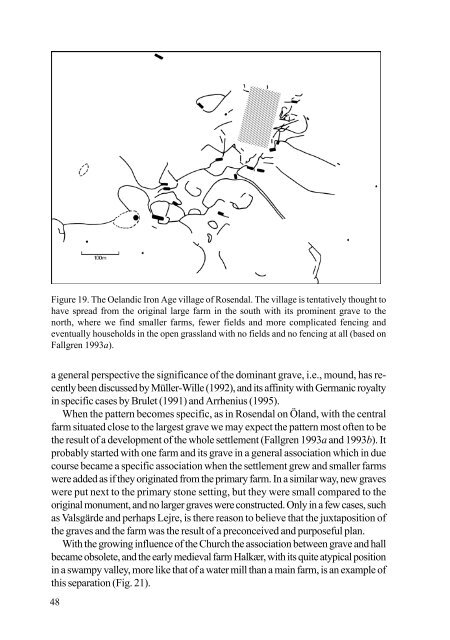Beowulf - Institutionen för arkeologi och antik historia
Beowulf - Institutionen för arkeologi och antik historia
Beowulf - Institutionen för arkeologi och antik historia
Create successful ePaper yourself
Turn your PDF publications into a flip-book with our unique Google optimized e-Paper software.
Figure 19. The Oelandic Iron Age village of Rosendal. The village is tentatively thought to<br />
have spread from the original large farm in the south with its prominent grave to the<br />
north, where we find smaller farms, fewer fields and more complicated fencing and<br />
eventually households in the open grassland with no fields and no fencing at all (based on<br />
Fallgren 1993a).<br />
a general perspective the significance of the dominant grave, i.e., mound, has recently<br />
been discussed by Müller-Wille (1992), and its affinity with Germanic royalty<br />
in specific cases by Brulet (1991) and Arrhenius (1995).<br />
When the pattern becomes specific, as in Rosendal on Öland, with the central<br />
farm situated close to the largest grave we may expect the pattern most often to be<br />
the result of a development of the whole settlement (Fallgren 1993a and 1993b). It<br />
probably started with one farm and its grave in a general association which in due<br />
course became a specific association when the settlement grew and smaller farms<br />
were added as if they originated from the primary farm. In a similar way, new graves<br />
were put next to the primary stone setting, but they were small compared to the<br />
original monument, and no larger graves were constructed. Only in a few cases, such<br />
as Valsgärde and perhaps Lejre, is there reason to believe that the juxtaposition of<br />
the graves and the farm was the result of a preconceived and purposeful plan.<br />
With the growing influence of the Church the association between grave and hall<br />
became obsolete, and the early medieval farm Halkær, with its quite atypical position<br />
in a swampy valley, more like that of a water mill than a main farm, is an example of<br />
this separation (Fig. 21).<br />
48








